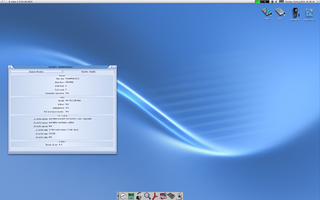 W
WAmbient is a MUI-based desktop environment for MorphOS. Its development was started in 2001 by David Gerber. Its main goals were that it should be fully asynchronous, simple and fast. Ambient remotely resembles Workbench and Directory Opus Magellan trying to mix the best of both worlds.
 W
WAmiExpress - also known as /X - by Synthetic Technologies was a popular BBS software application for the Commodore Amiga line of computers. AmiExpress was extremely popular among the warez scene for trading (exchanging) software.
 W
WAmiga demos are demos created for the Commodore Amiga home computer.
 W
WAmigaOS 4 is a line of Amiga operating systems which runs on PowerPC microprocessors. It is mainly based on AmigaOS 3.1 source code developed by Commodore, and partially on version 3.9 developed by Haage & Partner. "The Final Update" was released on 24 December 2006 after five years of development by the Belgian company Hyperion Entertainment under license from Amiga, Inc. for AmigaOne registered users.
 W
WA new version of AmigaOS was released on December 24, 2006 after five years of development by Hyperion Entertainment (Belgium) under license from Amiga, Inc. for AmigaOne registered users.
 W
WAMosaic is a discontinued Amiga port of the Mosaic web browser, developed beginning in 1993, and was the first graphical web browser for the Amiga. AMosaic was based on NCSA's Mosaic, but was not distributed by the University of Illinois or NCSA. It was developed by Michael Fischer at Stony Brook University, Michael Meyer at the University of California, Berkeley, and Michael Witbrock at Carnegie Mellon University. The first version was released to the public on December 25, 1993, and the last version available was a 2.0 prerelease.
 W
WThe Amiga Assampler is a software synthesizer and sample editor. Its features are:interactive graphical assembling of sound processes sounds with different sample rate or volume are automatically adjusted sound groups allow hierarchical storage and operations on multiple sounds at once no limit for multichannel sounds hard disk editing of raw non-interleaved sample sounds with no functional limit easy creation of control, modulation, waveform etc. curves frequency spectrum can be used both for viewing and manipulating a rich set of basic processes, e.g.: basics, echo, distortion, filters, FFT in principle everything can be run as realtime effect parameters can be given as mathematical expressions with complex numbers and SI units multithreading, you don't need to wait for a calculation to complete fast MC68000 assembly signal routines user interface written in Cluster
 W
WElastic Reality was a warping and morphing software application available on Windows, Macintosh, Silicon Graphics workstations and Amigas and was discontinued in 1999.
 W
WBasilisk II is an emulator which emulates Apple Macintosh computers based on the Motorola 68000 series. The software is cross-platform and can be used on a variety of operating systems.
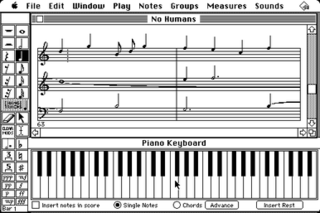 W
WDeluxe Music Construction Set (DMCS) is a 1986 music composition, notation and playback program for the Amiga and Macintosh. The program was originally released as Will Harvey's Music Construction Set for the Apple II and other computers, but was redesigned for the deluxe version. DMCS was created by Geoff Brown and published by Electronic Arts (EA). Ariolasoft published the program in Europe under license from EA.
 W
WDeluxe Paint, often referred to as DPaint, is a bitmap graphics editor series created by Dan Silva for Electronic Arts. The original Deluxe Paint was written for the Commodore Amiga 1000 and released in November 1985. It was eventually ported to other platforms, including an MS-DOS version which became the standard for pixel graphics in video games in the 1990s, the only competitor being Autodesk Animator Pro.
 W
WDirectory Opus is a popular file manager program, originally written for the Amiga computer system in the early to mid-1990s. Development on the Amiga version ceased in 1997, but an entirely re-written version of Directory Opus is still being actively developed and sold for the Microsoft Windows operating system by GPSoftware.
 W
WExcellence was a word processor for the Amiga computer, created by Micro-Systems Software as a follow-up to their earlier Scribble! word processor. The primary author was Steve Pagliarulo. It was one of the first WYSIWYG word processors for the Amiga.
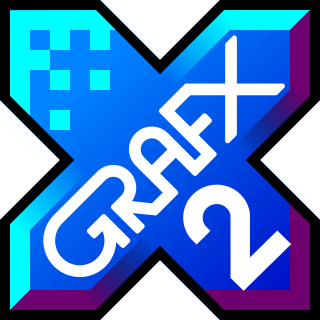 W
WGrafX2 is a bitmap graphics editor inspired by the Amiga programs Deluxe Paint and Brilliance. It is free software and distributed under GNU General Public License.
 W
WThe Magic User Interface is an object-oriented system by Stefan Stuntz to generate and maintain graphical user interfaces. With the aid of a preferences program, the user of an application has the ability to customize the system according to personal taste.
 W
WMicroEMACS is a small, portable Emacs-like text editor originally written by Dave Conroy in 1985, and further developed by Daniel M. Lawrence (1958–2010) and was maintained by him. MicroEMACS has been ported to many operating systems, including CP/M, MS-DOS, Microsoft Windows, VAX/VMS, Atari ST, AmigaOS, OS-9, and various Unix-like operating systems.
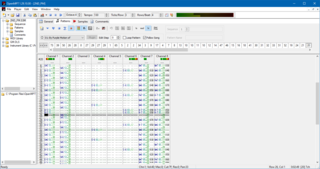 W
WA music tracker is a type of music sequencer software for creating music. The music is represented as discrete musical notes positioned in several channels at discrete chronological positions on a vertical timeline. A music tracker's user interface is usually number based. Notes, parameter changes, effects and other commands are entered with the keyboard into a grid of fixed time slots as codes consisting of letters, numbers and hexadecimal digits. Separate patterns have independent timelines; a complete song consists of a master list of repeated patterns.
 W
WPageStream is a desktop publishing software package by Grasshopper LLC, currently available for a variety of operating systems, including Windows, Linux, Macintosh, and Amiga. The software was originally released under the name Publishing Partner for the Atari ST in 1986.
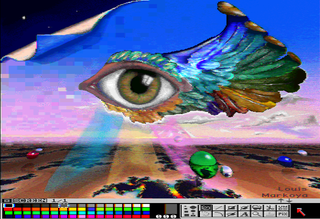 W
WPhoton Paint is a Hold-And-Modify (HAM) based bitmap graphics editor for the Amiga, first released in 1987. Photon Paint was the first bitmap graphics editor to incorporate 3D solid modeling and texture mapping as an integral part of the program.
 W
WThe Professional File System is a filesystem originally developed commercially for the Amiga, now distributed on Aminet with a 4-clause BSD license. It is a compatible successor of AmiFileSafe (AFS), with an emphasis on added reliability and speed compared to standard Amiga filesystems. It also features multi-user abilities like the older MuFS.
 W
WProTracker is a music tracker for the Amiga platform. A free software tool that required no additional equipment, it became popular in the early 1990s with both amateurs and professionals, allowing for sample-based music in the MOD file format.
 W
WRashumon was a multilingual graphical word processor developed for the Amiga computer by an Israel-based company called HarmonySoft and was sold until after the demise of Commodore in 1994. Rashumon had particular support for Hebrew, Arabic and Russian as well as English, and it could send its text to speech synthesis in English.
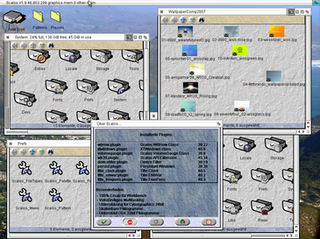 W
WScalos is a desktop replacement for the original Amiga Workbench GUI, based on a subset of APIs and its own front-end window manager of the same name. Its goal is to emulate the real Workbench behaviour, plus integrating additional functionality and an enhanced look. As stated on its website, the name "Scalos" was inspired by the fictional time-accelerated planet Scalos in the Star Trek episode "Wink of an Eye".
 W
WScript Creation Utility for Maniac Mansion Virtual Machine (ScummVM) is a set of game engine recreations. Originally designed to play LucasArts adventure games that use the SCUMM system, it also supports a variety of non-SCUMM games by companies like Revolution Software and Adventure Soft. It was originally written by Ludvig Strigeus. Released under the terms of the GNU General Public License, ScummVM is free software.
 W
WTurboPrint is a closed source printer driver system for Linux, AmigaOS and MorphOS. It supports a number of printers that don't yet have a free driver, and fuller printer functionality on some printer models. In recent versions, it integrates with the CUPS printing system.
 W
WUltimate Soundtracker, or Soundtracker for short, is a music tracker program for the Commodore Amiga. It is the creation of Karsten Obarski, a German software developer and composer at a game development company EAS.
 W
WVim is a clone, with additions, of Bill Joy's vi text editor program for Unix. Vim's author, Bram Moolenaar, based it on the source code for a port of the Stevie editor to the Amiga and released a version to the public in 1991. Vim is designed for use both from a command-line interface and as a standalone application in a graphical user interface. Vim is free and open-source software and is released under a license that includes some charityware clauses, encouraging users who enjoy the software to consider donating to children in Uganda. The license is compatible with the GNU General Public License through a special clause allowing distribution of modified copies "under the GNU GPL version 2 or any later version".
 W
WWordPerfect (WP) is a word processing application, now owned by Corel, with a long history on multiple personal computer platforms. At the height of its popularity in the 1980s and early 1990s, it was the dominant player in the word processor market, displacing the prior market leader WordStar.
 W
WThe XAD system is an open-source client-based unarchiving system for the Amiga. This means there is a master library called xadmaster.library which provides an interface between the client and the user application and there are clients handling the special archive formats. Three different types to handle file and disk archives and also disk image files (filesystem) are possible. They can be made by anyone. The master library itself includes some of these clients internally to make the work somewhat easier for the package maintainer and the user installing it.
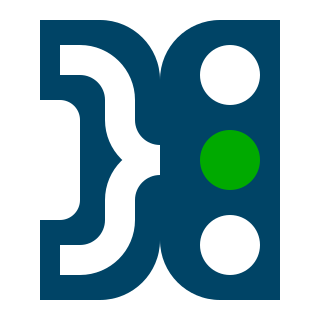 W
WXpdf is a free and open-source PDF viewer for operating systems supported by the Qt toolkit. Versions prior to 4.00 were written for the X Window System and Motif.
 W
WYAM is a MIME-compliant E-mail client written for AmigaOS and derivative operating systems. Originally created by Marcel Beck, it currently supports multiple user accounts, encrypted communications via OpenSSL and PGP, unlimited hierarchical folders and filters, a configurable GUI based on MUI, extensive ARexx support for automating tasks, and most of the features to be expected in modern E-mail clients.